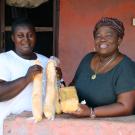This journal article, published online November 23, 2017, was authored by Leland Glenna, Yetkin Borlu, Thomas Gill, Janelle Larson, Vincent Ricciardi, and Rahma Adam. It is a result of the project "Strengthening the value chain for orange- and purple-fleshed sweet potatoes" in Ghana. The principal investigator for this project is Eunice Bonsi, Tuskegee University.
Abstract: Debates concerning how to achieve food security tend to fall into one of two camps. The first is that high-technology, market-oriented approaches promise to enhance agricultural productivity and improve food security. The counterargument is that low-technology approaches, when combined with building social and physical infrastructure, are more effective at meeting people’s food needs. Using a survey of 540 farm households in northern Ghana, we assess the level of food security for smallholders by analyzing the influence of a low-technology and low-external-input approach, such as sweet potatoes, and that of the production of an improved, commercially produced crop, such as rice. We also measure the influence of market access. Our results indicate that sweet potato producers are more likely to be food secure than commercial rice producers. However, the proximity to and interaction with markets is also associated with farmer food security, even when controlling for measures of prosperity. These findings suggest that low-technology approaches and high-technology, market-oriented approaches should not be treated as diametrically opposed to each other. Enhancing smallholder production of low-technology staple crops like sweet potatoes is likely to improve well-being. At the same time, interventions to build the physical and social infrastructure necessary to enable market participation would also be likely to enhance smallholder well-being.
Glenna, L., Y. Borlu, T. Gill, J. Larson, V. Ricciardi, and R. Adam R. 2017. Food security, sweet potato production, and proximity to markets in northern Ghana. FACETS 2: 919–936. doi:10.1139/facets-2017-0027

